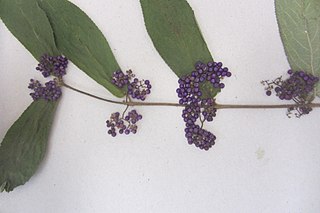Callicarpa maingayi is a species of beautyberry plant in the family Lamiaceae. It is found in Malaysia and Singapore.

Linnaea amabilis, also known under the synonym Kolkwitzia amabilis and the English name beauty bush, is a species of flowering plant in the family Caprifoliaceae. It is a deciduous shrub grown as an ornamental plant. In China, where it originated, the plant is wei shi shu (蝟实).

Callicarpa americana, the American beautyberry, is an open-habit, native shrub of the Southern United States which is often grown as an ornamental in gardens and yards. American beautyberries produce large clusters of purple berries, which birds and deer eat, thus distributing the seeds.

Callicarpa bodinieri, or Bodinier's beautyberry, is a species of flowering plant in the genus Callicarpa of the family Lamiaceae, native to West and Central China. Growing to 3 m (10 ft) tall by 2.5 m (8 ft) wide, it is an upright deciduous shrub with dark green leaves turning red in autumn (fall). In midsummer, small lilac flowers are produced in the leaf axils. But it is grown in gardens primarily for its small, decorative purple berries in tight clusters in autumn. While the berries are not poisonous, they are very bitter. Wildlife will not eat them until there are no other available food sources. This species is more tolerant of cold than C. americana.

Callicarpa japonica, commonly known as East Asian beautyberry or Japanese beautyberry, is a plant in the mint family.

Callicarpa dichotoma, the purple beautyberry or early amethyst, is species of beautyberry. They are cultivated as garden trees. The flowers are pink to white. The berries which are small drupes are purple. The fruits grow closely together in large clusters. The fruit provides food for wild life. The berries are bitter and are unfit for culinary use. This species can be found in China, Vietnam, Korea and Japan.

Callicarpa cathayana is a species of beautyberry. It is grown in gardens and parks as an ornamental plant for its decorative pink flowers and berries. The purple berries are a drupe. They are not edible for humans. Birds eat the berries and disperse the seeds. The species are endangered in the wild. Callicarpa cathayana is native to China.

Callicarpa formosana is a species of beautyberry. It is cultivated as an ornamental plant. The drupes resembling tiny clusters of berries are light-purple. The flowers are white. The tree is sometimes used to make herbal medicine. This species ranges from Taiwan to southern Japan.

Callicarpa kwangtungensis is a species of beautyberry. The tree is introduced in Europe as an ornamental plant. The fruit is light-pink and grows in small clusters. The flowers can range from pink to white. It is endemic to China. The berries are very bitter and inedible for human use. Birds and other wild life won't eat them unless all their food sources are depleted.
Callicarpa longifolia is a species of beautyberry. It ranges from the Himalayas, east to Japan and south to Queensland. It is grown in yards and gardens as an ornamental plant. The roots are used as an herbal medicine to treat diarrheas.
Callicarpa erioclona is a species of beautyberry native to Vietnam, Borneo, Sulawesi, Java, Philippines, New Guinea and the Bismarck Archipelago. It produces small berries that grow in tight clusters. The fruit is edible, but is not commercially grown or sold in markets. The flowers are light-pink to white. The leaves can be mixed with coconut oil to treat open wounds.

Callicarpa acuminata is a species of beautyberry native to Latin America from Mexico to Bolivia. Unlike the other species of this genus, C. acuminata produces small berry-like fruits which can be dark-purple or dark blue-purple. The fruit can sometimes be white. The flowers blooms are white. The fruit grow in tight clumps and sometimes resemble grapes. They are cultivated as garden trees.

Callicarpa tomentosa is a species of beautyberry plant in the family Lamiaceae. It is found in Western Ghats of India and Sri Lanka. It is a small tree with about 5m tall. Leaves simple, opposite; elliptic to broadly elliptic; apex acute or acuminate. Purplish flowers show branched axillary cymes. Fruit is 3-4 seeded globose drupe. Fruits provide food for wildlife. They are sometimes used to make herbal medicine. The leaves are also food for wildlife.

Callicarpa macrophylla is a species of beautyberry native to the Indian subcontinent. Its fruits are small white berries that actually are drupes.

Callicarpa nudiflora is a species of beautyberry that is grown as an ornamental plant. It is native to Southeast Asia.

Callicarpa mollis is a species of beautyberry that is cultivated and grown in gardens and parks as ornamental plant. It has purple flowers. It is found in Korea and Japan.

Callicarpa pedunculata is species of beautyberry native to Australia. It is a small tree or shrub. It produces dark-purple berries that are drupes. The leaves are green to brown. It is grown as an ornamental shrub. The fruit is astringent and too acidic to be eaten by people.

Callicarpa rubella is a species of beautyberry native to Southeast Asia. It is a shrub that produces pink or purple flowers followed by dark-purple berries. The berries are actually drupes. It is grown in gardens as an ornamental plant. The fruit attracts wildlife such as birds.

Callicarpenal is a terpenoid that has been isolated from plants of the genus Callicarpa (beautyberry). It acts as an insect repellent against mosquitoes and fire ants. It also has activity against ticks.

Callicarpa (beautyberry) is a genus of shrubs and small trees in the family Lamiaceae. They are native to east and southeast Asia, Australia, Madagascar, southeast North America and South America.
















